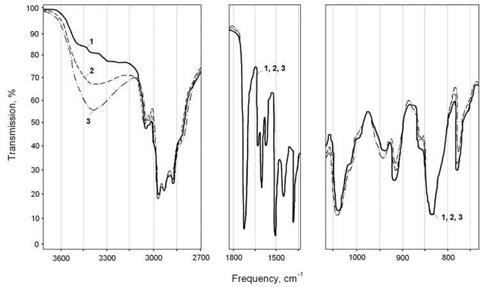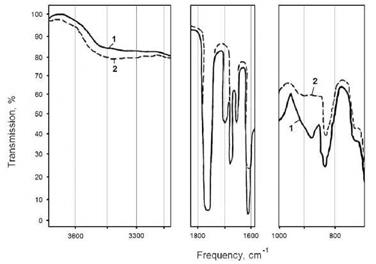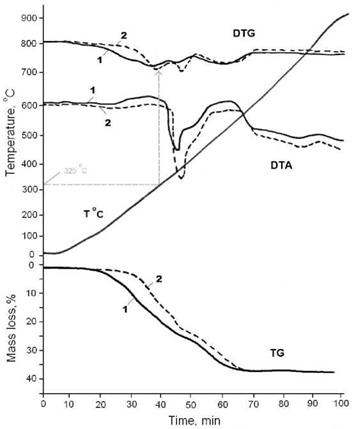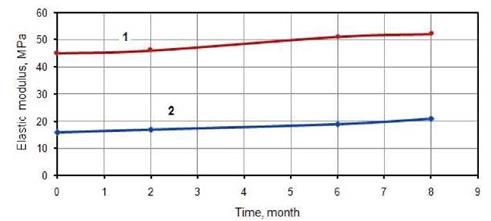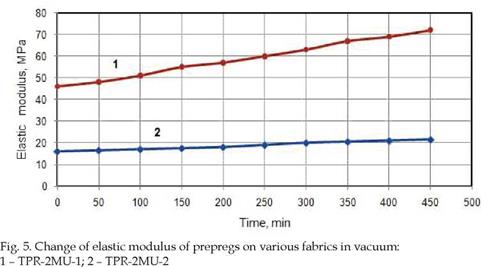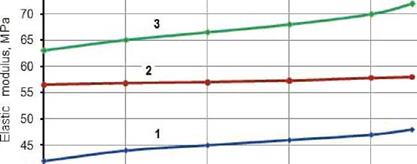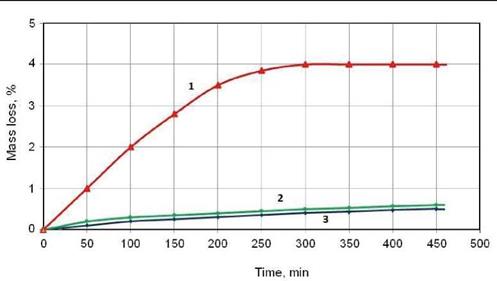Laricheva V. P.
Branch of FSUE "Karpov Institute of Physical Chemistry"
Obninsk, Kaluga Region, Russia
1. Introduction
In this article it is discussed the compact-packed materials, which acquire rigidity under the exposure to ionizing radiation. The prepreg materials, additionally curable under the irradiation exposure, can be used for the fabrication of large-size products (for example, supporting constructions of the large space antennas of space transport vehicles and aircrafts, protective shields of spacecraft and shielding constructions on the lunar surface); they can be transformed in the space environment and acquire rigidity (stability of form) under the influence of space factors (UV radiation, vacuum). The materials, additionally cured under the irradiation exposure, can be obtained with the use of specially developed complex binders, that include the components of different sensitivity to ionizing radiation and curable by different mechanisms.
One of the problems, that space researchers are facing, is the creation of easy and at the same time rigid structures transformed at a space environment to suit desirable applications in the specific conditions of the outer space. In particular, it can be structures for lunar settlements, bearing constructions of solar batteries, auxiliary or constructional materials for assembly or repair of constructions at space conditions.
The polymeric structures compactly packed on the Earth, transported in space, transformed at space conditions in the necessary configurations and acquiring desirable stability of shape under influence of space factors are most acceptable to these purposes. Such factors are the space vacuum, fluxes of radiation of the exoatmospheric Sun and the ionizing radiation of the outer space. It is important to note that radiation conditions on the moon surface coincide with those on spacecraft on the near-earth orbits.
The first researches in this direction were aimed at development of foldable metallic structures [1]. Use of metals in such structures made them heavy and, thus, unsuitable for large-size constructions. Also it is known that rigid foldable structures were obtained by impregnation of tight-sealed synthetic fabrics in water solution of gelatin. Rigidity of structure was got due to evaporation of water. Another procedure of increase of structure rigidity was accomplished by formation of hard foam hardening due to the effect of the space factors on the binders impregnating "sandwich". This method was used on the American satellite ECHO-2. However, it was not possible to obtain the structure of exact configuration, and the method was not acceptable for large-size products [2].
Interest in the unfolded constructions which can be used for the solution of problem in the generation of electricity at space and its transfer to earth by solar batteries has intensified recently again [3-5].
Use of film-type solar batteries for these purposes is especially effective. The absence of the effective constructions of unfolding and maintenance of the form of solar batteries in flight is obstacle on the way of the effective realization of the film-type solar batteries technology. These problems are solved due to the use of the frameless centrifugal space constructions
[5].
For these purposes it is offered to create the non-sticky intermediates of products made of the prepregs, received on the basis of specially created complex binders. Such binders consist of the components, which are polymerized by different mechanisms, such as polycondensation (or step-by-step addition) and radical polymerization. In this case it is possible to separate these reactions in the time and to obtain the non-sticky pre-fabricated compact-packed products, which can be additionally hardened by ionizing radiation and other space environment factors even after long storage at 40 °С [6-7].
The experiments were executed to obtain binders for the prepregs, based on the components, which are polymerized by the radical mechanism. For it unsaturated compounds (mostly polyester oligomers) were selected as binder components. Polymerization of polyester oligomers can be initiated at the exposure to UV radiation, y – quanta and accelerated electrons. In the absence of radiation initiators these compounds are not polymerized and, thus, they can serve as plasticizers at the obtaining of prepregs due to other components of complex binder.
The components, polymerizing by step-by-step addition or polycondensation, can be selected from a wide group of substances. It can be epoxy oligomers with different hardeners, epoxy novolac, phenol formaldehyde, silicon-organic and other oligomers depending on the desirable polymerization rate and properties of the finished product. As a rule, polymerization of such compounds is initiated by high doses of the ionizing radiation. Our research focuses on the compositions of epoxy oligomers with different hardeners. This selection is not random. According to our papers [8-10], radiation resistance of epoxy compositions, both hardened and non-hardened, depends on the type of the used hardener and, therefore, the process can be controlled to the desirable way.
The prepregs were prepared by immersion of different fabrics into binder compositions. The excess of binder was removed by the rollers. Then the impregnated fabrics were stretched on the mandrels. The mandrels, intended for shaping of samples, were first protected by polyethylene to avoid the sticking of binder.
The following fabrics were used: capron, phenylone, arimide, fiberglass fabric grade EZ-100 P, sulphone, CVM-4, and carbon fabric T10-XO. To obtain better wettability, capron underwent preliminary washing. However, even after washing capron poorly was impregnated, but the other fabrics showed the good impregnating properties.
Depending on composition, the prepregs were prepared by three ways: 1) cold hardening; 2) hot hardening; and 3) radiation hardening (exposure to low-dose electron radiation in the accelerator «Electron 3M», 400-700 keV energy).
The samples of the prepregs were additionally hardened by accelerated electrons in the energy range from 300 keV to 3 MeV on different accelerator facilities, by fluxes of radiative energy from the lamp SVD-120A (at 100 mm from the lens, i. e., 0.05 W/cm2 full flux intensity, and UV radiation at < 384 nm, ~ 0.025 W/cm2) and from the lamp DKcR-3000 (UV intensity in 200 – 400 nm is ~3 Suns, that is in 3 times higher than UV radiation intensity of the exoatmospheric
Sun on the Earth orbit) in vacuum (about 10-5 mmHg) on the facility IC-600/300. This facility was designed for the UV exposure of the large lots of the samples of materials at different temperatures (from 30 to 200 °С and above) in high vacuum. On this facility the samples can be exposed to UV irradiation separately or simultaneously in two working chambers with a capacity of 300 liters and 600 liters by fluxes of irradiative energy from the xenon arc lamps of ultrahigh pressure of the type DKcR-3000, DKcShRB-3000 or DKcShRB-5000 at different intensities. Special target devices were developed to expose material samples of various types by different UV energies. At low doses of UV radiation (to 5 ~ 7 equivalent solar days) plated targets were used for film-type, textile and flat samples for the construction materials.
On Figures l and 2 the IR spectra are presented for epoxypolyester complex binder used in the formation of prepregs. Spectroscopy investigations make it possible to understand the mechanisms of the processes taken place at the creation of such materials, both at the stage of obtaining and at further radiation hardening. It is observed on Figure l that at the stage of formation of prepreg the changes occur only in the epoxy components of the complex binder. In this case the chemical hardening of prepregs (with amine hardener) is accompanied by decrease of epoxy group content during the time (at 910 cm-1 band) and simultaneous increase of hydroxyl group content (at 3450 cm-1 band). Radiation additional hardening (Fig. 2) of prepregs occurs due to opening double bonds (decrease of bands intensity and even disappearance at 1650 cm-1 and 760 cm-1) in the polyester component of complex binder. In this case is observed also that additional hardening of prepregs can proceed with participation of residual epoxy groups in the epoxy components of complex binders. Therefore, the band of intensity of hydroxyl groups increases at 3450 cm-1, while intensity of epoxy groups decreases, according to the IR spectral data of the UV exposed binder. The efficiency of this process depends on the type of hardener.
|
Fig. 1. Kinetics of hardening (IR-spectra) of epoxypolyester binder: 1 – right after preparation; 2 – in a day after preparation; 3 – in 10 days |
|
Fig. 2. IR-spectra of epoxypolyester binder: 1 – non-irradiated; 2 – irradiated by electrons, dose 0.05 MGy |
|
№ |
Composition |
Exposure energy, e. s.h.* |
Gel-fraction, % |
|
1 |
Epoxypolyester binder, aliphatic amine as hardener, fabric SVM-4 |
0 1 10 |
71.82 95.76 98.3 |
|
2 |
Epoxypolyester binder, aliphatic amine as hardener, fiberglass fabric |
0 10 |
69.2 90.2 |
|
3 |
Epoxypolyester binder, aliphatic amine as hardener, Capron fabric (hot hardening) |
0 10 |
66.1 90.4 |
|
4 |
Epoxypolyester binder, aliphatic amine as hardener, Phenylone fabric (hot hardening) |
0 1 10 |
70.8 77.44 97.9 |
|
5 |
Epoxypolyester binder, aromatic amine as hardener, fabric SVM-4 |
0 1 10 |
72.2 90.1 97.9 |
|
6 |
Epoxysilicoorganic polyester binder, aliphatic amine as hardener, fabric SVM-4 |
0 1 10 |
56.9 87.9 93 |
|
7 |
Epoxypolyesterstyrene binder, aliphatic amine as hardener, fabric SVM-4 |
0 1 10 |
79.48 95.22 100 |
|
8 |
Epoxyacrylamide binder, aliphatic amine as hardener, fabric SVM-4 |
0 1 10 |
80 76.37 30 |
Additional hardening of the binder lead to the increase gel-fraction, and the most intensive crosslinking occurs during the first hour of radiation exposure as follows from Table 1. The process of additional hardening completely concludes in polyester on double-bonds at energy exposition of about 10 equivalent solar hours as proved by disappearance of the band at 1650 cm-1 and ~100 % of gel-fraction (Fig. 2, Table 1). The finished cross-linked product has the higher heat resistance (315 °С), than initial polyesters (280 °С). Therefore, as a whole new composite material will have higher values of heat resistance as compared to the initial prepreg, this is clearly shown by the differential thermal analysis (Fig. 3). It should be noted that additional hardening of the prepregs depends on the binder composition and is practically independent of the fabric type (Tables 1-3). However, the properties of the prepregs and additionally hardening composites and, consequently, products on their base depend on fabric characteristics. After long storage of the fiberglass prepregs it is easy to identify bending lines on the samples. At the place of bending the sealing properties become low. It looks like fiberglass fabric cuts a hardened binder. Therefore, this fabric was not used in further experiments.
|
Fig. 3. Differential thermal analysis of hot-hardened prepregs based on epoxypolyester binder: 1 – non-irradiated binder; 2 – 10 hours after UV irradiation |
According to Table 2, the strength of both the prepregs and the finished compositional materials (or products) is defined also by binder composition. In the process in all cases during additional hardening by UV radiation the mechanical strength very strongly increases, while the relative elongation decreases. These dependences are valid for all fabrics used in the research (Table 3). It should be noted, that the strength of the compositional materials (and therefore, products on their base), additional hardened by space-simulated factors (UV exposure about 10 equivalent solar hours or electron radiation about 0.03 MGy), decreases only by 40 % and for sulphone fabric even by 20 % at thermal tests of 200 °С.
After additional hardening by the UV-radiation or by the accelerated electrons the composite materials, based on the carbon fabric of grade T-10-X0 (GOST 15170-73), acquire the highest strength, i. e. 1177 MPa in comparison with ~ 147 MPa for the samples, based on the other fabrics. However, this fabric is unsuitable for fabrication the prepregs, since finished products badly roll up into rolls. Most probably the fabric samples required for this objective should be much thinner.
It is significant that after radiation processing the characteristics of the prepregs, in particular rigidity, and of the finished products on their base noticeably depend on the properties of the initial fabrics (Fig. 4). On this Figure the initial rigidity of prepregs on the fabrics of grade TPR-2MU-1 on SVM fiber is 3 times higher than on the fabric TPR-2MU-2 on arimide filament, though the same binder and the same regime were used to obtain both prepregs. Moreover, these prepregs have different vacuum resistance that is obvious on Fig.
5. The initial rigidity of prepregs can be increased, without change of characteristics of tightness and capability to compact packing, due to the irradiation by the low doses of
|
Before irradiation |
After irradiation – 10 e. s.h.* |
||||
|
№ |
Prepreg composition |
Tensile strength, MPa |
Relative elongation, % |
Tensile strength, MPa |
Relative elongation, % |
|
1 |
Epoxypolyesterstyrene binder, aliphatic amine as hardener, fabric – Phenylone |
73.3±6.9 |
40±4 |
134.1±4.1 |
19±2 |
|
2 |
Epoxypolyester binder, aliphatic amine as hardener, fabric – Phenylone |
39.8±2.9 |
38±3 |
67.8±1.7 |
29±7 |
|
3 |
Epoxypolyester binder, aromatic amine as hardener, fabric – Phenylone |
61.8±3.4 |
25 |
127.7±6.9 |
13±2 |
|
4 |
Epoxysilicoorganic polyester binder, aliphatic amine as hardener, fabric – Phenylone |
28.0±1.9 |
33±2 |
118.0±1.3 |
6±1 |
|
Fabric type |
Before irradiation |
After irradiation – 10 e. s.h.* |
||||||||
|
Gel, % |
Temperature of testing, °C |
Gel, % |
Temperature of testing, °C |
|||||||
|
<7, MPa |
є, % |
7, MPa |
є, % |
|||||||
|
20° |
200° |
20° |
200° |
20° |
200° |
20° |
200° |
|||
|
Phenylone (analogs: Nomex, Konex) |
73 |
80.4 |
51.0 |
26 |
29 |
98.2 |
92.2 |
58.8 |
15 |
27 |
|
SVM-4 (analog: Technor) |
72 |
147.4 |
103.4 |
9 |
14 |
95.4 |
169.2 |
123.5 |
6 |
9 |
|
Arimide (analog: Р-84) |
72 |
88.3 |
52.8 |
23 |
26 |
97.6 |
106.2 |
63.7 |
14 |
25 |
|
Carbon fabric |
806.7 |
523.7 |
9 |
12 |
1176. 7 |
823.7 |
4 |
8 |
||
|
Sulphone |
71.8 |
41.2 |
31.6 |
35 |
27 |
95.7 |
53.9 |
36.3 |
28 |
30 |
|
*e. s.h. – equivalent solar hours о – tensile strength £ – relative elongation |
Table 3. Physico-mechanical properties of the prepregs based on different fabrics (more than a year storage life)
|
Fig. 4. Change of elastic modulus during storage of prepregs depending on the initial fabric structure: 1 – prepreg on fabric TPR-2MU-1 and epoxypolyester binder; 2 – prepreg on fabric TPR-2MU-2 and epoxypolyester binder |
0.0025 or 0.005 MGy (Fig.6). In conditions of vacuum the values of mass loss decrease from 4 % to 0.5 % (Fig. 7). The pre-fabricated products, based on the special compositions of binder, acquire the shape stability at exposure to electron irradiation about 0.03 MGy and above and to UV irradiation not less than 10 equivalent suns. In this case the rigidity values (estimated by the elasticity modulus at bending on the sample based on fabric TPR-2MU-1) of the non-
irradiated prepreg and irradiated by dose 0.0025 MGy are 12.2 MPa and 12.8 MPa respectively. Accordingly, the products based on these prepregs acquire rigidity of 160 MPa and 174 MPa after additional UV hardening by 10 equivalent suns. At the same time a factor of thermal expansion do not change. The products obtained by such procedure have resistance to dose of 1 MGy. On exposure to space factors the heat resistance of the cured composite materials is 105 °С.
|
|
75
|
|
40
0 100 200 300 400 500
Time, min
|
Fig. 7. Egress of volatile substances of the prepregs formed by different methods (on one binder) at irradiation in vacuum: 1 – non-irradiated; 2 – radiation dose 0.0025 MGy; 3 – radiation dose 0.005 MGy |
2. Conclusions
0. It is shown that the non-sticky intermediate products (prepregs), which can be compactly packed on the Earth and be opened in the space conditions, can be prepared by three ways depending on composition: 1) cold hardening; 2) hot hardening; 3) radiation hardening (hardening by low doses of electrons, at such doses the samples are soft and can be compact packed).
1. It is possible to carry out the additional hardening of the intermediate products (prepregs) by accelerated electrons with the energies from 300 keV to 3 MeV on different installations by doses of the order of 0.03 MGy and by UV-radiation in the field of 200-400 nanometers at an exposition of the order of 5-10 e. s.h. also. Thus the samples acquire the shape stability.
2. It is shown that on the basis of the combinations of special complex binders, polymerizing by different mechanisms, and high-strength fabrics, it is possible to develop the pre-fabricated products, which can be compact packed on the Earth and in the sequel be unfolded in the space conditions. Under exposure of space environment these products can acquire shape stability and sufficient strength and, thus, they become suitable for assembling or repairing the constructions in the space conditions.
3. The products received thus stand the irradiation doses more than 1 MGy.

